DevOps as a Services: Ultimate Guide
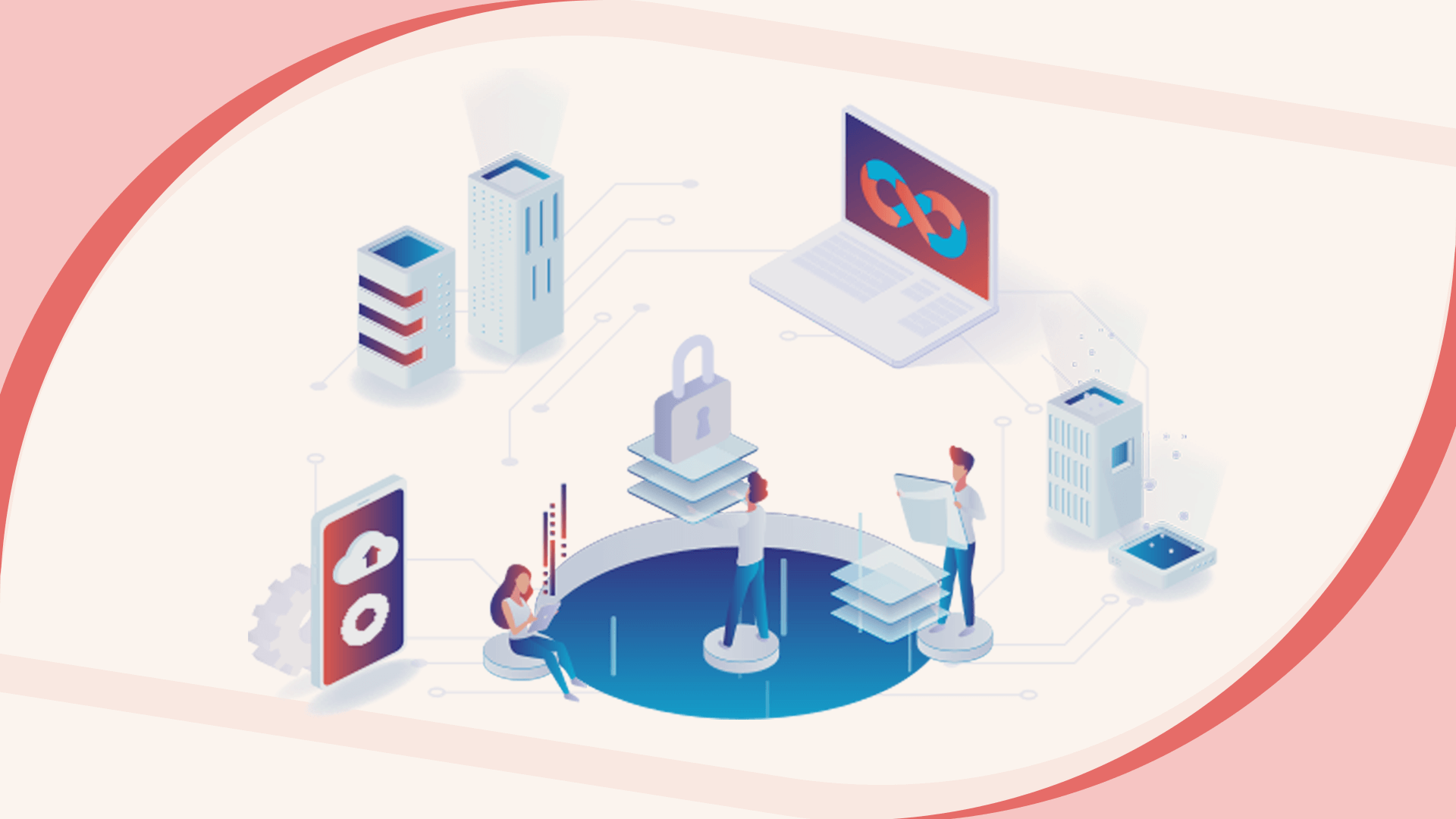
DevOps as a service - here is the ultimate guide. As the digital realm continues to grow in complexity, business organizations are always looking for novel ways of optimizing their software development features and improving overall workforce performance. There is one such revolutionary approach called DevOps– a methodology that blends development and operations teams together to enable better collaboration, automate workflows and deliver premium quality software faster.
DevOps as a service provides this revolutionizing approach in the form of convenient and easily reachable solutions, available to organizations which can benefit from professional help required for the implementation and management of DevOps practices. In a never-ending pursuit to gain an upper hand over the competition, more organizations are investing in DevOps services and with respectable revenues of about $4,461.2 million in 2019, it is projected that global revenue would reach up to $23,362.8 million by 2027.
DevOps is vital. DevOps eliminates silos between development and operations, thereby creating a culture of unity in work resulting in continuous change. This leads to fast software delivery, thereby reducing time-to-market and improving the product quality - key factors contributing to competitiveness today.
In this all-encompassing narrative dedicated to DevOps, we’ll go past the basics and explore core beliefs practiced in it as well showcase tools which are vital for its application. This article will help you understand everything from the basics of concepts to real-life case studies and best practices that one needs as a start in DevOps.
Whether you are an IT specialist who wants to improve the software development life cycle of your organization or a business leader aiming at realizing full potential in digital initiatives, this guide targets meeting both types. Come with us to the futuristic world of DevOps and see how it can reshape your approach towards building, releasing, and operating software solutions.
Prepare yourself for an innovative, collaborative and constantly developing path with DevOps as a service.Let's dive in!
What is a DevOps Service?
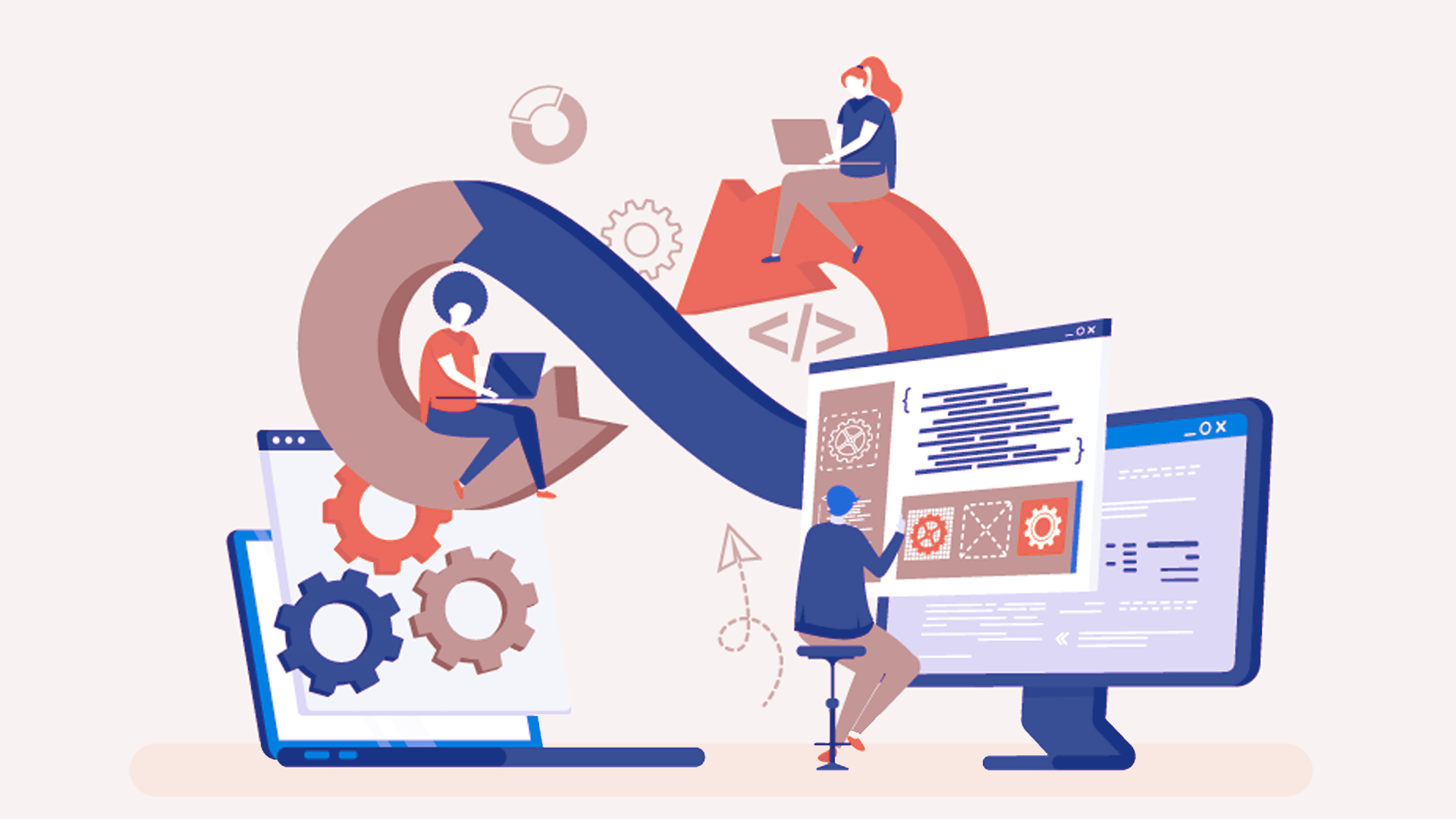
DevOps services encompass an all-embracing method in the development and delivery of software that integrates cultural philosophies, practices as well as tools to promote collaboration between teams from both ends; i.e., software developers/development and IT operations. It is in the current software development where agility, scalability and reliability are at play that DevOps services contribute a great deal towards organizational success.
By essence, DevOps services are aimed at combating traditional boundaries between development and operations leading to a culture of integration openness and continuous delivery. Enabling development, quality assurance and operations teams to align their goals and workflows is a primary way DevOps boosts software product delivery with precision while guaranteeing operational stability in production.
The key principles and objectives of DevOps services revolve around several core tenets:
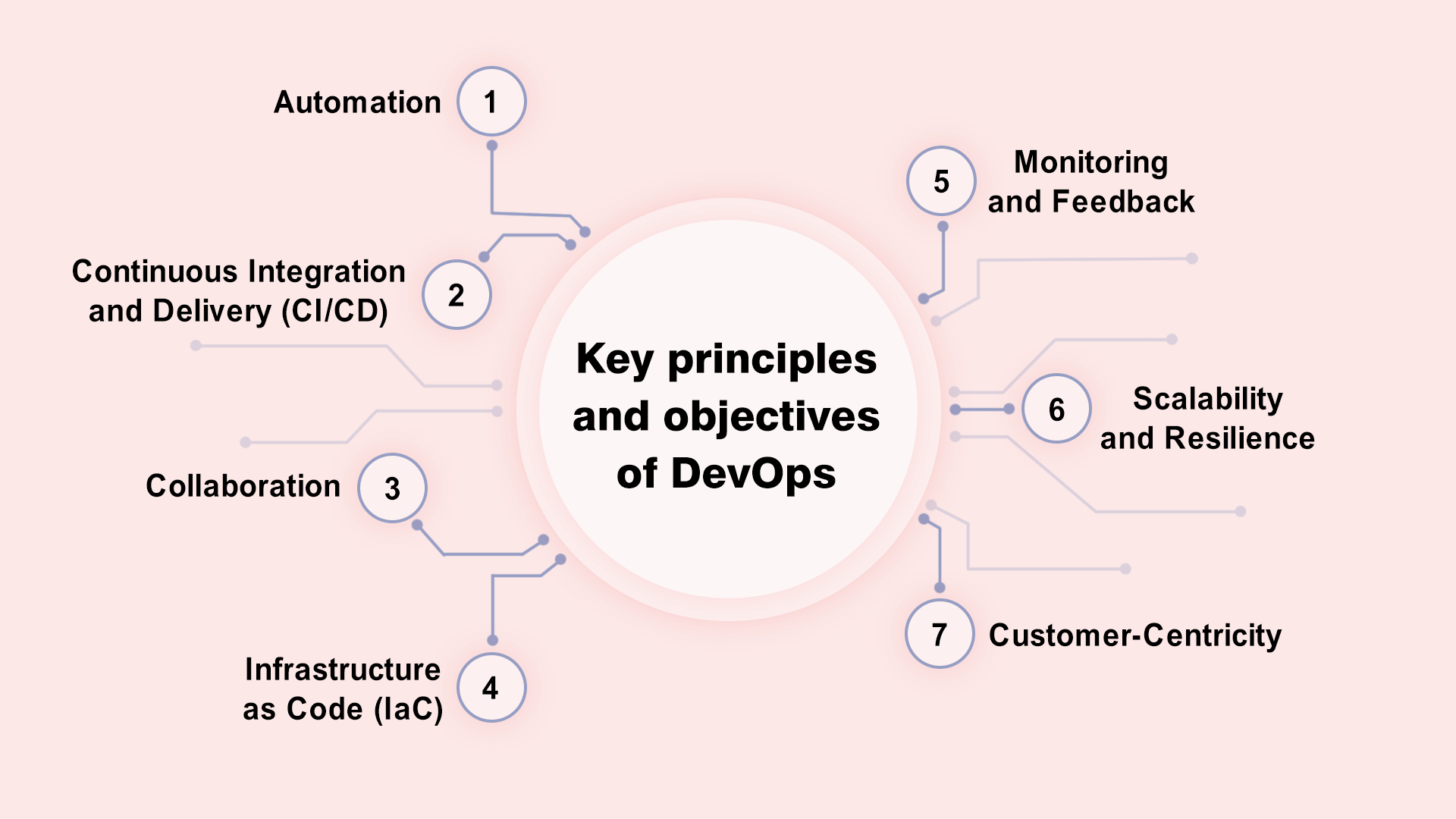
- Automation: DevOps focuses on the automation process of manual processes, such as code deployment, testing, and Infrastructure provisioning to promote efficiency reduction errors and rapid iteration.
- Continuous Integration and Delivery (CI/CD): CI/CD pipelines serve as the core of DevOps practices by enabling teams to automate code changes’ build, test and deployment, allowing for quicker release cycles leading to higher agility.
- Collaboration: In DevOps, the culture of teamwork and common responsibility between development, operations, as well as other stakeholders is promoted; cross-functional collaboration improves sharing knowledge.
- Infrastructure as Code (IaC): IaC principles are fostered by DevOps wherein it is programmatically managed; the deployment can be consistently and repeatedly done in different environments.
- Monitoring and Feedback: DevOps focuses on continuous performance monitoring of applications, infrastructure quality and user feedback, allowing teams to catch problems early and continuously improve their systems.
- Scalability and Resilience: DevOps services are positioned to design scalable, stable and fault-tolerant systems that can evolve with changing needs without undue disruption.
- Customer-Centricity: Finally, the purpose of DevOpt is to increase customer value more quickly and reliably by aligning development activities with customer requirements and business goals.
In doing so, the organizations can fully harness DevOps services possibilities to promote innovation and agility thereby granting leadership in today’s digital era. DevOps services lead to better time-to-market, product quality, and anything else that helps you improve your day to day business operations.
DevOps Solutions: Seven Main Practices
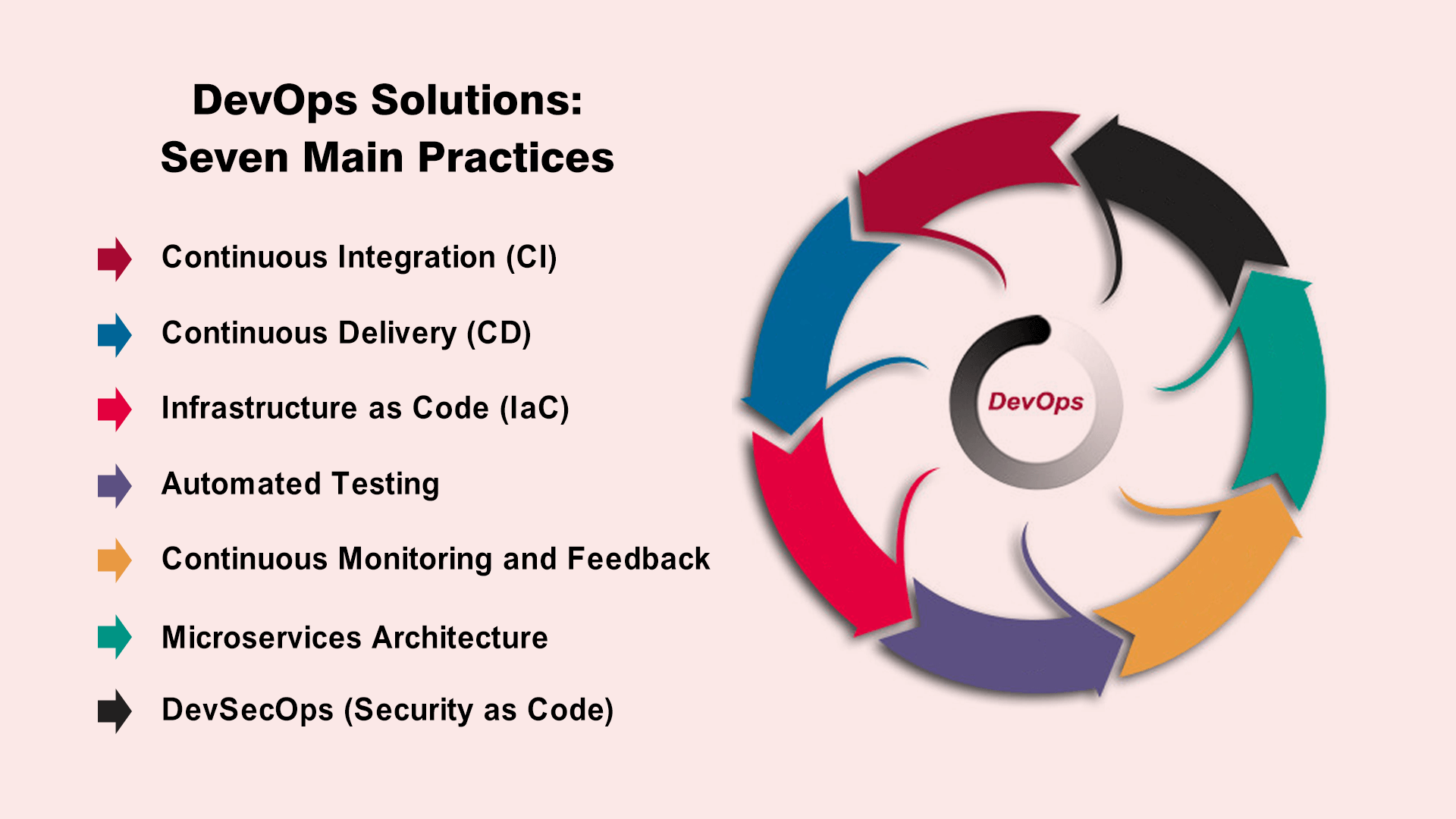
DevOps refers to a collection of practices aimed at promoting collaboration, automation and continuous improvements in all phases of the software development life cycle. Through the use of these practices, organizations can simplify their processes, improve delivery time as well as increase software quality.
Let's delve into the seven main practices of DevOps:
Continuous Integration (CI)
In continuous integration, multiple developers’ code changes are frequently merged into a shared repository followed by automated builds and tests. This guarantees continuous code changes integration and validation, decreasing the number of integration issues accomplished early in a development cycle; teams may find bugs. Tools such as Jenkins, GitLab CI, and Travis CI support the automation of this process by providing a means to build and test code automatically every time there are changes.
Continuous Delivery (CD)
Continuous Delivery brings the concepts of CI one step further by automating code change deployments into production-like environments in a controlled and predictable way. Teams can use CD to guarantee software releases are always in a deployable state that could be deployed into the production environment anytime. Automation of deployment pipelines and the use of other approaches like blue-green deployments as well canary releases reduce downtime, allow for risk mitigation, and enable organizations to present new features quickly. With tools such as Spinnaker, AWS CodePipeline or Azure DevOps at their disposal, teams are able to automate not only the deployment process but also release pipelines.
Infrastructure as Code (IaC)
Infrastructure as Code is the approach to manage and provision infrastructure resources using codes or automation tools. By configuring infrastructure through code, teams can manage their infrastructures as software enabling version-controlled and repeatable deployments. IaC tools such as Terraform, AWS CloudFormation and Ansible automate provisioning and configuration of infrastructure resources enabling teams to spin up/down environments easily, dynamically scale resources without experiencing hiccups in application performance across different environments.
Automated Testing
Automated Testing refers to the process of applying automated testing frameworks and tools at all stages of development aimed at validating software functionality, performance, and security. Automatic testing allows teams to identify defects early, monitor code quality as well establish quicker feedback loops. There are various types of automated tests, including unit tests, integration tests and end-to-end testing; which validate different aspects of the software. Tools such as Selenium, JUnit and Postman automate the test execution and reporting which allows the team to run tests continuously.
Continuous Monitoring and Feedback
Continuous Monitoring refers to the real-time monitoring of application and infrastructure metrics, logs, and events that can detect performance problems; security vulnerabilities as well as other abnormalities. System behavior can be analyzed, issues proactively troubleshooted and performance improved by collecting data from production environments in the teams’ application by means of telemetry. Continuous Feedback mechanisms like user feedback, customer surveys, and incident reports come in handy by giving the necessary insights into user satisfaction and areas that need improvement. Tools such as Prometheus, Grafana and ELK Stack allow the teams to monitor application metrics with greater effectiveness boosting system reliability performance.
Microservices Architecture
Microservices Architecture is an architectural style that divides large monolithic applications into smaller, loosely coupled services each of which can be developed, deployed and scaled independently. Through the decomposition of complex systems into small units that can be managed at scale, teams are able to test and iterate quickly while innovating effectively so individual services grow by demand. Microservices allow teams to implement DevOps practices including CI/CD, automated testing, even infrastructure as code with less trouble thereby promoting agility and resilience in software development.
DevSecOps (Security as Code)
DevSecOps embeds security practices into the DevOps process, making sure that attention is paid to this aspect throughout all stages of software development. Embedding security controls, vulnerability assessments, and compliance checks into CI/CD pipelines helps teams identify potential issues early on which reduces the amount of inherent risk in a project’s infrastructure while ensuring that regulations have been met. DevSecOps promotes collaboration among development, operations and security teams for collective responsibility in proactive risk management. Tools such as SonarQube, OWASP ZAP and Twistlock enhance security testing by automating compliance checks helping teams build secure resilient software solutions.
Adopting these seven core DevOps practices allows organizations to create an environment of collaboration, automation and continuous improvement that helps them deliver software faster, more reliably and with more agility.
DevOps Services: Methodologies & Lifecycle
Methodologies and lifecycle models are integral to the world of DevOps services where they dictate how teams work together, formulate plans, and carry out their software development or delivery processes. Although DevOps is not prescriptive as a methodology, it accommodates several agile elements and practices to build an environment of cooperation. Let's explore how methodologies such as Agile, Scrum, and Kanban fit into the DevOps lifecycle:
Agile Methodology
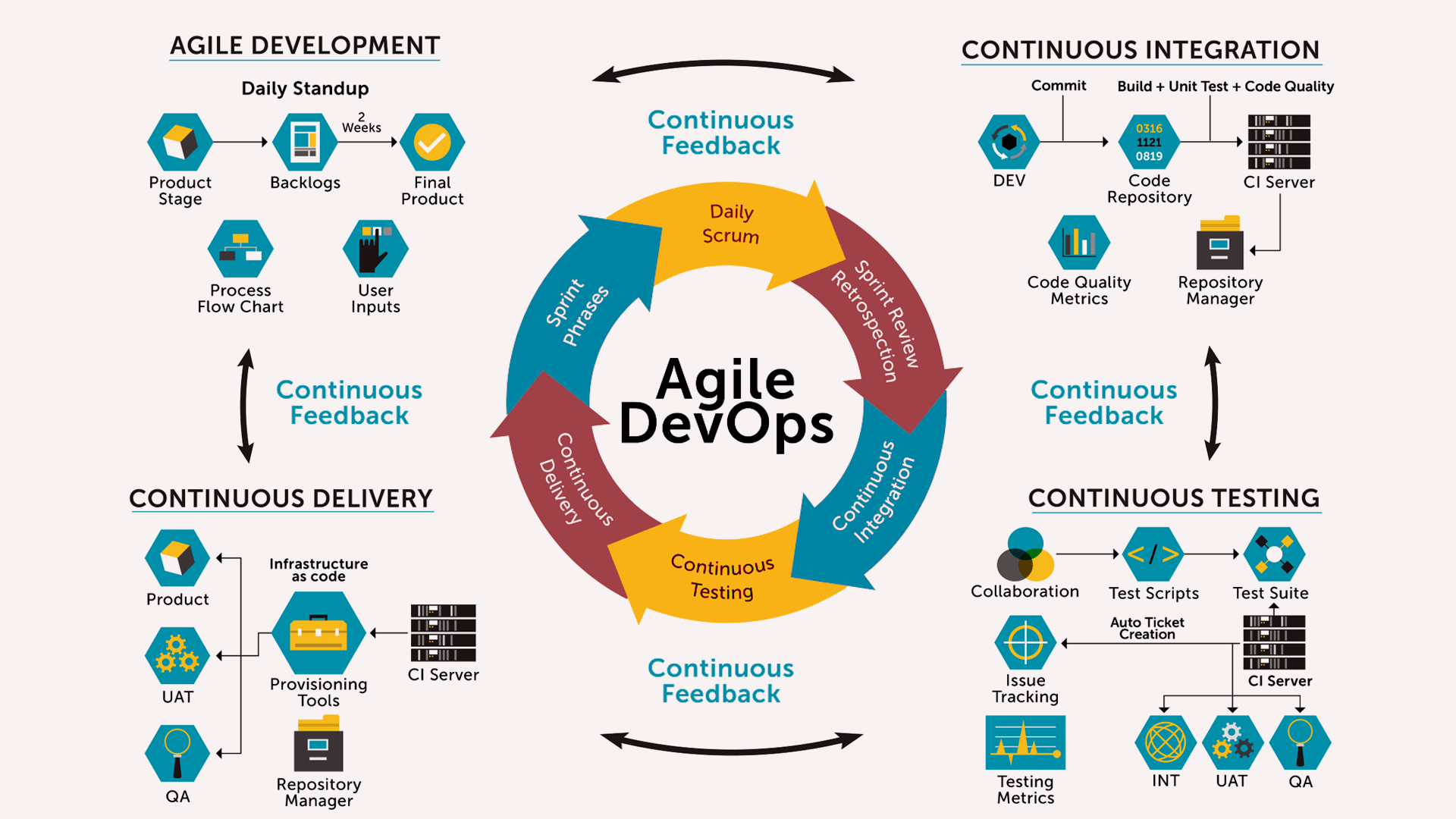
Characteristics of Agile includes iterative and incremental development, cross-functional collaboration towards customer value delivery early in the project. The agile principles, including customer collaboration being responsive to change and delivering working software correspond well with the core ethics of DevOps. Agile allows teams to manage projects in increments, prioritizing feedback and adaptation so that they may react quickly to changes of requirements or markets. Agile is the fulcrum of continuous integration, continuous delivery and also for ongoing feedback in DevOps lifecycle that drives agility by encouraging responsiveness during the development phase.
Scrum Framework
Scrum is an Agile framework for managing and delivering complex projects that are characterized by short, time-boxed iterations called sprints with regular inspection and adaptation through ceremonies such as the Sprint Planning Meeting, Daily Standup meetings, the Retrospective Meetings. Scrum creates a formal framework for product development, promoting visibility and teamwork among cross-sector teams. In the DevOps life cycle, Scrum works as a method that determines what work to do and when through an organized process of prioritization. The integration of DevOps principles, such as continuous integration and delivery within the sprint cycle helps Scrum teams to shorten their development cycles making its easy for them to deliver value by ensuring a smooth flow.
Kanban Methodology
Kanban is a visual management method that seeks to optimize workflow based on continuous improvement, also known as lean manufacturing. Kanban focuses on the work visualization, WIP limitations and flow optimization. For the DevOps, Kanban offers teams with a more dynamic and flexible approach of managing their distributions that help them to visualize tasks, prioritize workloads and identify bottlenecks for balancing process operations effectively. With the whole value stream, including ideation to delivery, made visible Kanban eliminates waste and shortens lead times as well that delivers values in a more predictable way. In the DevOps lifecycle, Kanban enhances Agile and Scrum practices by serving as a lightweight framework used in managing work and ensuring continuous improvement all across an organization.
In general, methodologies like Agile, Scrum and Kanban are irreplaceable frames for teams to follow during the DevOps cycle that let them work together to always improve product quality and achieve focus on customer interests in a fast way. Adopting agile principles and practices enables organizations to embrace a culture of constant learning and innovation, which is the recipe for success in today’s rapidly changing business environment.
Top 10+ Tools & Third-Party Solutions used for DevOps Services
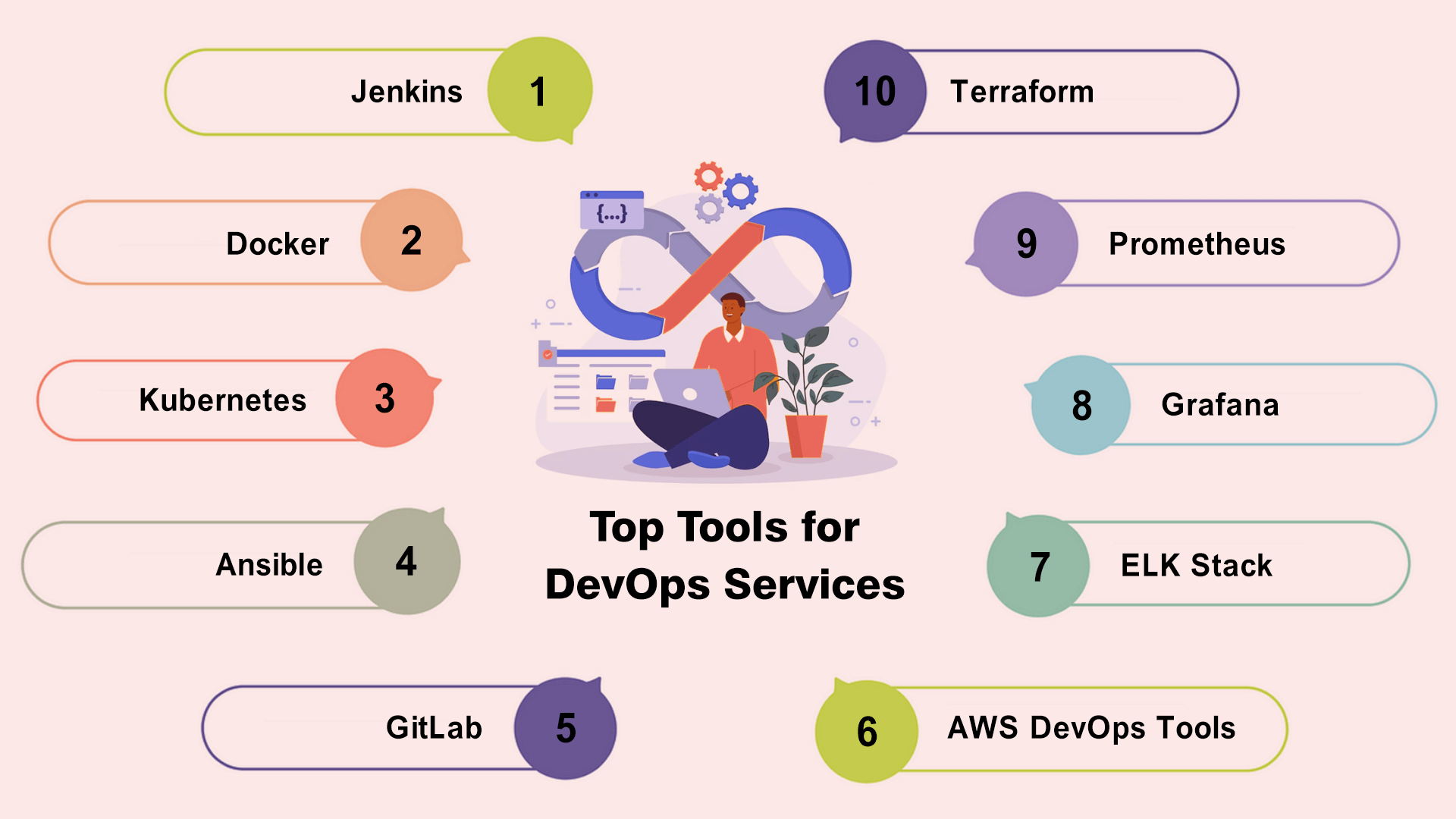
As the modern-day DevOps world works in a hurry, having proper tools and suitable third party solutions are essential to smoothen workflows, automate processes as well as improve software delivery rates. From continuous integration and delivery to infrastructure management and monitoring, here are some of the most popular tools and third-party solutions used in DevOps practices:
Jenkins
Jenkins is an open-source automation server, commonly used for CI/CD. It helps teams to do automatic build, test as well as deployment of code changes allowing for shorter release cycles and better quality software. Jenkins comes with a humongous ecosystem of innumerable plugins and integrations that can be personalized according to the specific demands of every development team.
Docker
Docker is a popular containerization platform used for packaging the application together with its dependencies into lightweight and deployable containers. With Docker, the underlying infrastructure is abstracted away and teams can build; ship for production and run applications across environments smoothly ranging from development to production.
Kubernetes
Kubernetes is an open-source container orchestration platform that automates the provisioning, scaling and managing of application containers. Such functions as automated scheduling, self-healing and service discovery make Kubernetes simplify the administration of multi container environments that are highly available and scalable.
Ansible
It has been used mostly for teams that can use it to automate such as configuration management, application deployment and infrastructure provisioning. Ansible can simplify extensive, heterogeneous environments by automating repetitive tasks; it uses human readable YAML syntax.
GitLab
GitLab is a comprehensive DevOps platform that offers integrated solutions for source code management, CI/CD and collaboration. It provides teams with the ability to integrate all aspects of the software development lifecycle in one platform features including Git repository hosting, issue tracking and automated pipelines.
Terraform
Terraform is an infrastructure as code (IaC) tool that enables teams to specify their desired resources with declarative configuration files. Terraform supports multiple cloud providers and services, allowing teams to manage infrastructure like application code - improving consistency, reliability & scale.
Prometheus
Prometheus is an open-source monitoring and alerting toolkit used for application performance/availability monitoring. Prometheus helps teams understand the state of their systems’ health, letting them identify potential problems and resolve issues before they even occur.
Grafana
Grafana is an open-source analytics and visualization software that enables users to create dashboards, graphs for monitoring data from services like Prometheus , Elasticsearch or InfluxDB. Equipped with support for various data sources and display formats, Grafana helps teams visualize their metrics in real-time.
ELK Stack (Elasticsearch, Logstash, Kibana)
The ELK Stack is an array of open-source tools used in log management and analytics. Elasticsearch is a distributed search and analytics engine, Logstash is an ingestion and processing tool of logs, Kibana provides visualization options with dashboarding facility. Combined, they become an effective tool to gather, analyze and display log data that helps teams understand their applications & infrastructure.
AWS DevOps Tools (AWS CodePipeline, AWS CodeBuild, AWS CodeDeploy)
For firms using Amazon Web Services (AWS), AWS provides an array of DevOps toolkits that facilitate the automation of software delivery pipelines. AWS CodePipeline coordinates build, test and deploy of code changes while AWSCodeBuild provides scalable build environments; finally it is accomplished through automated deployments to EC2 instances Lambda functions.
These are only a few of the many tools and third-party solutions that DevOps teams have at their disposal. All of the mentioned tools have distinct features, advantages and workflows which allow teams to customize their toolchain according to specific needs and preferences. In using the appropriate tools and technologies, organizations can optimize their DevOps practices; collaborate better thus delivering value to customers more quickly and effectively.
Simple 5-Step Flow for DevOps Outsourcing

Organizations opting for outsourced DevOps solutions can achieve it as a strategic decision aiming at reducing the overhead in software development by utilizing third-party specialized expertise and faster time to market, among others. Here's a simple five-step flow for outsourcing DevOps services:
- Define Requirements
The first thing to define when outsourcing DevOps services is your requirements and set the main goals. Define your organization’s unique DevOps needs, challenges and objectives including the introduction of faster release cycles , better automation or infrastructure management. Providing precise and comprehensive requirements will make it possible to convey your expectations clearly when you are looking for vendors, thereby ensuring consistency throughout the whole outsourcing cycle.
- Select a Vendor
Once you have defined your requirements, the next step is to choose a vendor who can offer DevOps services. Perform comprehensive analysis and assessment of possible vendors on the basis that might include their expertise, past performance and customer rating. Seek providers who have a history of success in providing DevOps solutions to customers and are knowledgeable about your industry and technology stack. Have conversations, request bids and interview vendors to gauge the vendor capabilities ensuring it suits your organization’s needs.
- Onboarding
However, once a vendor has been selected. Work closely with the vendor to ensure effective communication is created, a project scope and timeframes are determined, delivery expectations have been realized. Make available required systems, tools and documentation along with knowledge transfer sessions to vendors so as they know your environment well enough. Creating effective communication and a positive rapport from the very beginning will pave the way for an efficacious outsourcing union.
- Monitor Progress
Tracking progress and performance during the outsourcing activity helps ensure that project objectives are met adequately. Monitor critical performance indicators (KPIs), including timelines of projects, quality standards on deliverables and adherence to budgets among many others. Ensure effective communication with the vendor and address queries or challenges in a proactive way. By actively tracking progress risks can be averted, resources optimized and project success ensured.
- Optimize
The last stage of outsourcing DevOps services deals with continuous process improvement by using feedback and lessons learned. Perform post project reviews and retrospectives to determine performance, have points for improvement noted down as possible best practices. Leverage the knowledge derived from your engagement with outsourcing as a starting point for improving DevOps strategy, increasing cooperation among internal and external teams, and speeding up implementation of continuous improvement in software development procedures. By adopting a culture of learning and adaptation, you can ensure the true value extracted from outsourcing DevOps services leads to continued success in your organization’s digital efforts.
Why Should You Consider Outsourcing?
The outsourcing of DevOps services presents several benefits that have a strong effect on the organizational software development and delivery capabilities. At first, outsourcing can create large cost advantages which are due to avoidance of in-house infrastructure investments costs, hiring and training expenses for accumulating a dedicated DevOps team. With the help of outside assistance, companies can benefit from skills and expertise that they may not have within their own organizations, thus allowing them to follow best practices in terms of adopting technologies or tackling challenges.
In addition, outsourcing provides scalability and agility which allow organizations to grow people resources based on project requirements or business needs without the complexities of hiring FTEs. This agility allows organizations to respond promptly as market conditions change and adjust with technology subsequent trends so they can remain competitive. Further, outsourcing DevOps services can help in fast time-to market as the vendor brings his/her expertise and established processes so that an organization could deliver top quality products at a faster rate.
Furthermore, outsourcing DevOps services can increase operational efficiency focusing the internal resources on core business activities enabling organizations to use time and financial capacities more effectively. Allowing DevOps to be taken up by skilled professionals will ensure that internal teams are engaged in innovations, product development and customer engagement for growth of the business.
In conclusion, outsourcing DevOps services provides an attractive value proposition by providing cost savings and saving time for the organization to achieve strategic business goals based on effective software development.
DevOps Services: 5 Core Benefits
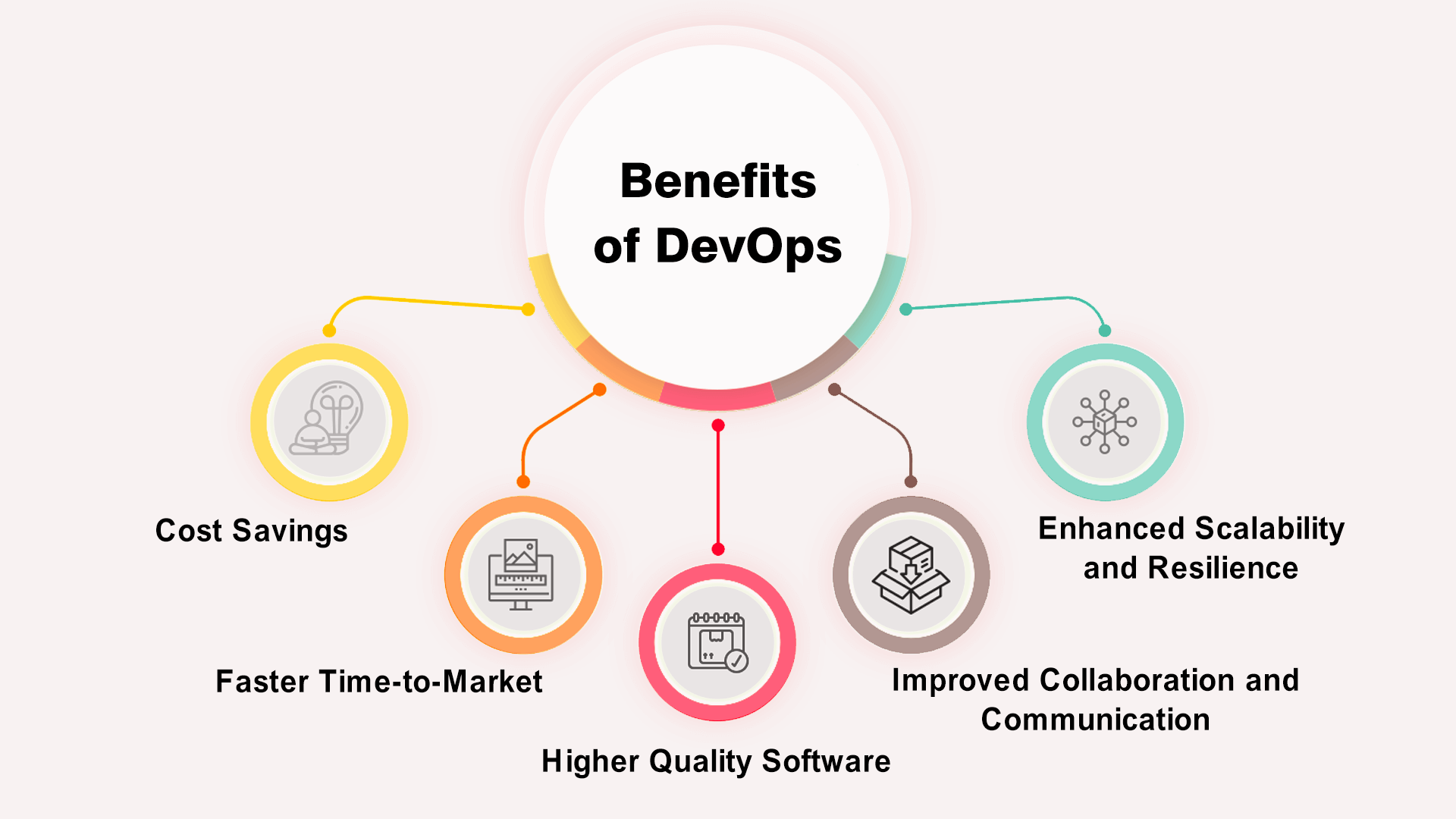
Implementation of DevOps services guarantees several advantages for organizations that revolutionize their software development and delivery processes, increase collaboration levels as well promote growth. Let's delve into the five core benefits of embracing DevOps services:
Cost Savings
Adoption of DevOps services brings substantial cost savings as one that is a major advantage. Through the process streamlining, task repetition automation and resources efficiency optimization organizations can reduce operation overweight as well as infrastructure costs related to conventional software development. Adopting DevOps allows organizations to bring advantage of cloud services and utilize containerization technologies, automation tools in order to increase efficiency and ultimately – save on expenses. Moreover, outsourcing Devops services can lead to additional cost saving benefits by eradicating the need of investing in expensive infrastructure and specialized manpower thereby leaving organizations free for fulfilling their core mission and strategic goals.
Statistics from Puppet highlight the fact that companies that outsource DevOps enjoy immense benefits such as zero time spent addressing security issues, 25x faster recovery from failures, 22% less unplanned work, 5% fewer reworks, and 3x lower failure probability. The primary outcome of DevOps is improved cost & value feedback for two digital projects without them. Notwithstanding that DevOps engineers' potential cost up to $200 per hour, it pales in comparison with long-term gains. The cost of DevOps outsourcing depends on the particular location. For instance, Eastern Europe provides a lot of viable DevOps outsourcing solutions that are offered at an affordable costing.
Faster Time-to-Market
DevOps allows organizations to speed up their time-to-market in software products by integrating continuous integration and delivery (CI/CD) pipelines, automatizing deployment procedures as well as facilitating fast iterations and comments. As DevOps allows for the elimination of silos between development, operations and other stakeholders it is able to develop a culture where there is collaboration thus ensuring transparency and agility that would enable them deliver new features updates among others within shorter intervals time lines. Faster release cycles and smaller feedback loops allow organizations to adapt quickly according to the changes in demands of customers, market response as well competition pressure; thereafter getting a leading position on the platform.
Higher Quality Software
Another important advantage of using DevOps services is the provision of quality software products. With the help of automated testing, code analysis, and quality assurance processes incorporated into the development pipeline through DevOps to identify bugs, vulnerabilities as well performance issues at an early stage in life cycle. Teams can keep track of application performance, detect bottlenecks and improve system reliability and resilience through continuous monitoring with feedback mechanisms. Driven by increased visibility, traceability and control over the software delivery process organizations can guarantee that their products adhere to quality standards, regulatory compliance as well as customer expectations at all times.
Improved Collaboration and Communication
DevOps promotes a culture of teamwork, information sharing and shared ownership between development teams, operations units as well as other transverse groups. DevOps helps teams to work together with transparency and accountability enabled; this enables alignment of goals, priorities etc. facilitating value delivery through efficient means for the benefit of customers. In coordinating tasks, resolving issues and innovating by collaborative means; real time communication tools as well platforms give way to knowledge sharing-and decision-making. Better collaboration and communication lead organizational leaders to overcome common hurdles in success like misalignment, misunderstandings, and inefficiencies that drive enterprise-wide productivity as well the innovative spirit.
Enhanced Scalability and Resilience
Finally, DevOps helps organizations to create flexible and agile software solutions that are not only reliable but can adapt as the needs of their users change. Through cloud-native architectures, microservices approach and infrastructure as code (IaC) principles, DevOps allows teams to build applications that are elastic in nature easily balancing traffic spikes without collapsing under the weight of disruptions. Automated scaling, self-healing and disaster recovery mechanisms make sure that applications are always available to run under varying conditions and load. By improving scalability and resilience, organizations are able to prop future-proof their software solutions thus reducing risks arising thereof while taking advantage of the new opportunities for growth.
Implementing DevOps services also provides several attractive advantages, namely cost reduction, faster time-to-market, better software quality, improved collaboration and communication as well enhanced scalability and resistance. Through the adoption of DevOps principles and practices, organizations can change their software development processes through innovation for a sustainable business success in this digital economy.
How Can You Benefit from Addevice’s DevOps Solutions?

Businesses can discover a realm of opportunities in software development and delivery with the aid of DevOps solutions from Addevice. Our DevOps solution provides organizations with the agility, efficiency and reliability they require in order to thrive amidst competitive pressure.
At Addevice, we provide an extensive range of DevOps services best suited for modern business environments. With the help of our team weapons inherited DevOps engineers that apply industry best practices, advanced technologies and proven methodologies to bring tangible results in business growth.
Our holistic approach to software development and delivery is one of the characteristics peculiar only to Addevice’s DevOps solutions. As a full-scale DevOps provider, we step in at the beginning of the process with making plans and gathering requirements to successful continuous integration deployment monitoring. Through seamless integration with your current processes and workflows, we ensure a hassle-free transition to the DevOps methodology leading to faster time to market, better quality of software products delivered by development teams and enhanced operational efficiency.
As well, Addevice provides various professional and customized services aimed at resolving some particular problems or needs. Our team is competent in infrastructure automation, containerization continuous integration and delivery or cloud migration all we know how to help you reach a set goal.
By partnering with Addevice for your DevOps needs, you can benefit from:
- Faster time-to-market: Simplify the delivery of your software pipeline and bring new features and updates to market quicker.
- Higher quality software: Ensure code quality, test reliability and security using automated testing.
- Enhanced scalability and resilience: Produce survivable, agile and flexible software applications that can also broadcast parallel-to your business.
- Cost-effective solutions: Get the best ROI by adapting cost-friendly DevOps services designed as per your needs and budget.
With DevOps solutions from Addevice, you can realize the full potential of your software development initiatives and foster sustainable growth and innovation within an organization. Let us help you change your business, and fulfill all dreams with confidence.
Conclusion
In conclusion, the trip around the DevOps world has led to numerous advantages and prospects for organizations who are interested in improving their software development management. The benefits of DevOps, such as increased efficiency and shorter time-to-market are unmistakable.
As you prepare to venture into the journey of DevOps and make all that lies within your software development a success, look no further than Addevice. Our robust DevOps portfolio coupled with a highly skilled team of engineers will be standing by your side all the way!
Get in touch with us now to find out more about how Addevice could utilize the DevOps model for your company and provide you with an innovative solution that will enable incredible agility, success, as well as flexibility. Combined, we will change your organization’s software development processes and help you achieve the goals of your business with confidence. Let us turn your DevOps vision into reality.
Transform Your Development Process with DevOps as a Service
With our proven expertise in DevOps, we empower businesses to streamline their development lifecycle and accelerate delivery of high-quality software.
Our DevOps services include:
✅ Continuous Integration/Continuous Deployment (CI/CD)
✅ Infrastructure as Code (IaC) implementation
✅ Automated Testing and Monitoring
Table of contents
FAQ
The price offered by Addevice on outsourcing DevOps services would vary with the requirements and scope of your project. We provide competitive pricing that fits within your budget and needs. Reach out to us for a tailor-made quote and free consultation.
At Addevice we value the open lines of communication with our clients. We offer dedicated project managers and communication channels for smooth engagement. Furthermore, we provide regular updates to the client regarding status updates on progress reports and consultation through feedback sessions.
The DevOps solutions offered by Addevice can be used in various industries such as finance, healthcare, e-commerce and telecommunications among others. Our agile and adaptive service model enables us to design services specific for the needs of different industries as far as compliance is concerned.
How long it takes to see results from Addevice’s DevOps services also is driven by the characteristics of your project and its complexity, level of maturity for existing processes, as well as goals that you set yourself. Yet, our iterative and agile methodology allows us to provide incremental value and measurable results at every single stage of the engagement.
Yes, Addevice provides comprehensive support and maintenance programs for DevOps solutions post-implementation to ensure their effective implementation in the long term. Our team offers proactive monitoring, troubleshooting and performance improvements to ensure that your systems run optimally. In addition, we provide regular updates and upgrades to cope with changing business demands and technological developments.
 How Much Does It Cost to Build a Messaging App?
How Much Does It Cost to Build a Messaging App?
 How to Create an NFT Marketplace: Development Guide
How to Create an NFT Marketplace: Development Guide
 Must-Have Uber App Features: Building a Ridesharing App
Must-Have Uber App Features: Building a Ridesharing App